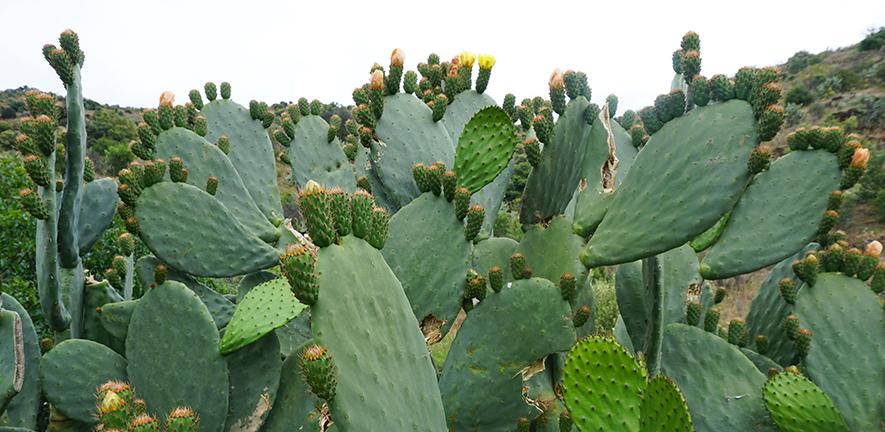
Submitted by Anonymous on Mon, 13/11/2023 - 15:04
The A to B of pigmentation evolution in Caryophyllalesceae
Major steps taken towards solving a classic mystery of plant evolution
A new study by Boas Pucker, Nat Walker-Hale and Jasmina Dzurlic in Samuel Brockington’s Evolution and Diversity group, working in partnership with colleagues at the Technical University of Braunsweig, Germany, and the Universities of Nevada and Minnesota - Twin Cities in the USA, comprehensively profiles for the first time the genetic mechanisms responsible for the loss of anthocyanins in betalain pigmented species in the taxonomic order Caryophyllales (a diverse order that includes carnations, tamarisk and cacti), and shows that these losses likely occurred repeatedly during multiple origins of betalain pigments.
Anthocyanins are widely known as pigments of fruits and flowers in a wide range of plant families, and play important roles in plant reproduction and their defence against pests and pathogens. Unusually, some plants of Caryophyllales have replaced their anthocyanins with water-soluble betalains, and the possible reasons and mechanisms for this mutual exclusion have captured scientists’ interest over many decades.
Understanding how the molecular pathways that create anthocyanins in the Caryophyllales has changed can help shed light on the evolutionary shift to betalains, and can help us understand whether such changes occurred once or many times independently.
Hypotheses testing
The team set out to test four hypotheses to explain the loss of anthocyanins, investigating 18 flavonoid pathway genes and six regulatory genes covering four transitions to betalain production in over 350 species in 31 families, and found support for three of them:
1. Gene loss: there was a loss of a key anthocyanin-producing enzyme, orthologues of Arabidopsis TT19, which are responsible for the final stage of anthocyanin synthesis and have been lost from all examined betalain-pigmented species.
2. Gene expression: there was reduced expression of late-stage flavonoid pathway genes such as the biosynthesis genes DFR and LDOX.
3. Regulatory evolution: in many anthocyanin-pigmented species, anthocyanin expression is controlled by a triplet of transcription factors called the MBW complex. In betalain-pigmented species, key elements of this complex are degenerated or coopted.
Interestingly, the team’s fourth hypothesis, that anthocyanin pathway genes should show widespread loss of function in betalain-pigmented species, was not supported. They suggested that this was because two sets of precursors of anthocyanins, called anthocyanidins and flavonoids, are widely maintained in betalain-pigmented Caryophyllales, and hence the genes associated with producing them are maintained as well.
Understanding the genetics of anthocyanin loss
These results are the first comprehensive assessment of the genetics of anthocyanin loss in Caryophyllales, which were previously only known from single mechanisms in very few species. Due to the apparent total loss of a key enzyme, they suggest that betalain-pigmented species revolving anthocyanins in future seems unlikely. Interestingly, the changes the team noted at the scale of a whole order seemed to match the changes observed during loss of anthocyanins on much more recent time scales, suggesting that evolution is proceeding similarly despite very different contexts. The results make big steps in solving a charismatic plant mystery that has frustrated biologists for decades. Now that the ‘how’ of these changes are known, there are many more opportunities to ask why some species would prefer betalains to anthocyanins, perhaps due to a unique benefit of betalains.
Joint first author on the paper, Nat Walker-Hale, said: “This was a really exciting project, using widely sampled genomic and gene expression data to answer shed light on a classic mystery in plant evolution, and firmly grounding anthocyanin evolution in Caryophyllales in what is known from other groups.”
Read the paper
Pucker, B., Walker-Hale, N., Dzurlic, J., Yim, W.C., Cushman, J.C., Crum, A., Yang, Y., Brockington, S.F. 2023. Multiple mechanisms explain loss of anthocyanins from betalain-pigmented Caryophyllales, including repeated wholesale loss of a key anthocyanidin synthesis enzyme. New Phytologist (2023) https://doi.org/10.1111/nph.19341
For more information
Please contact joint first author Nat Walker-Hale
[Header image by Tanja Friebott on Wikimedia Commons]
